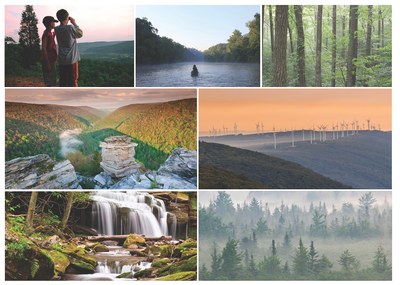New Study Looks at Future of Appalachian Energy Development
 The study and online mapping tool were developed by Nature Conservancy researchers through a grant from the Appalachian LCC—one of a nationwide network of 22 partnerships linking science with management to sustain natural and cultural resources at large, regional scales. The study assesses energy development potential and trends of wind, shale gas, and coal and shows where these may overlap with important natural resources and associated benefits—such as municipal drinking water supplies—giving a full picture of what future energy development could look like in the Central and Southern Appalachians.
The study and online mapping tool were developed by Nature Conservancy researchers through a grant from the Appalachian LCC—one of a nationwide network of 22 partnerships linking science with management to sustain natural and cultural resources at large, regional scales. The study assesses energy development potential and trends of wind, shale gas, and coal and shows where these may overlap with important natural resources and associated benefits—such as municipal drinking water supplies—giving a full picture of what future energy development could look like in the Central and Southern Appalachians.
The online tool displays maps of potential energy development model results and potential overlap with examples of valued natural areas—such as intact forests and vital watersheds—to show users where potential intersections could occur. The model results can be downloaded and overlaid with other available natural resource information by users to identify additional intersections of natural resources and potential energy development areas. This will help provide information to industry, agencies, environmental organizations, and others to initiate effective collaborative dialogue on how to balance energy development and natural resource conservation.
“The Appalachians are a national and global hotspot for terrestrial and freshwater diversity, consisting of a large network of intact deciduous forests and the point of origin for drinking water supplies for 22 million people throughout the Mid-Atlantic,” said David K. Whitehurst, Director, Bureau of Wildlife Resources for the Virginia Department of Game and Inland Fisheries and Chair of the Appalachian LCC Steering Committee. “As wind and natural gas energy expand along with traditional coal development, there is an increasing need for such forward-looking research to inform discussions on how to meet immediate energy needs, while sustaining the health of natural systems for longer-term environmental and economic benefits.”
Whitehurst added that the study and mapping tool, both informed by industry input, underscore the Appalachian LCC’s commitment to serve as a forum for collaboration and to deliver science that informs natural resource conservation planning and action in balance with the needs of people.
Key findings include:
- nearly 7.6 million acres (an area larger than the state of Massachusetts) of new energy-related development may expand across the Appalachian region by 2035;
- an estimated 5.3 million acres (roughly the size of New Jersey) of this new energy-related development is most likely to occur in forested areas;
- more than 150 watersheds, which are reliant on forest cover to produce clean water to major cities and communities, occur in these same areas; and
- future energy development may be concentrated in the Allegheny and Cumberland Plateaus.
Thomas Minney, Director of The Nature Conservancy’s Central Appalachians Program, said the study builds on previous Conservancy research on potential shale gas and wind energy development within the Marcellus shale region. The LCC-funded study is designed to predict potential energy development across the Appalachian Region, including natural gas, coal, and wind. This includes assessing shale gas development (including Utica shale); wind-powered energy production opportunities; and further development of traditional surface mining coal extraction across the entire Appalachian LCC region.
“This study is part of a scientific planning process that intends to bring land management agencies, energy companies, and policymakers together to examine and minimize impacts on natural resources over wide geographical areas in the long-term with the goal of avoiding impacts wherever feasible and minimizing impacts that cannot be avoided,” Minney said. “Hopefully, it will help open the door to productive dialogue, as well as collaborative and long-term solutions that sustain people and nature in the Appalachians for generations to come.”
To view the assessment and access the online tool, visit: applcc.org/assessing-future-energy-development.
The Appalachian LCC serves as a catalyst and forum for landscape-scale planning and design by providing the tools, methods, and data resources that managers need to address land-use pressures and resource challenges that are beyond the scope of any one organization. By identifying, prioritizing, and supporting fundamental scientific research through coordination and strategic investment, the LCC is fostering the development and use of vital information and decision-support tools to help target the right conservation actions in the right places to ensure the future of natural resources in balance with the needs of people. Learn more about the Appalachian LCC-funded research and partnership by going to: applcc.org.
The Nature Conservancy is the leading science-based organization working globally to protect ecologically important lands and waters for nature and people. The Conservancy and its more than one million members have protected nearly 120 million acres and more than 5,000 river miles worldwide. Its Development by Design approach provides a smarter way to meet human infrastructure needs while maintaining healthy, functional natural systems. Learn more about The Nature Conservancy and its work in the Appalachians at nature.org/centralappalachians.






















